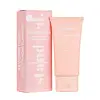What's inside
What's inside
 Key Ingredients
Key Ingredients

 Benefits
Benefits

 Concerns
Concerns

 Ingredients Side-by-side
Ingredients Side-by-side

Water
Skin ConditioningAloe Barbadensis Leaf Juice
Skin ConditioningRosa Damascena Flower
Skin ConditioningSqualane
EmollientCetearyl Olivate
Sorbitan Olivate
EmulsifyingPropanediol
SolventPropylene Glycol
HumectantCetyl Alcohol
EmollientHydrolyzed Wheat Protein
Skin ConditioningAllantoin
Skin ConditioningPolyacrylate Crosspolymer-6
Emulsion StabilisingAnthemis Nobilis Flower Extract
MaskingGluconolactone
Skin ConditioningCucumis Sativus Fruit Extract
EmollientCalcium Gluconate
HumectantSodium Phytate
Citric Acid
BufferingPhenoxyethanol
PreservativeSodium Benzoate
MaskingEthylhexylglycerin
Skin ConditioningPotassium Sorbate
PreservativeWater, Aloe Barbadensis Leaf Juice, Rosa Damascena Flower, Squalane, Cetearyl Olivate, Sorbitan Olivate, Propanediol, Propylene Glycol, Cetyl Alcohol, Hydrolyzed Wheat Protein, Allantoin, Polyacrylate Crosspolymer-6, Anthemis Nobilis Flower Extract, Gluconolactone, Cucumis Sativus Fruit Extract, Calcium Gluconate, Sodium Phytate, Citric Acid, Phenoxyethanol, Sodium Benzoate, Ethylhexylglycerin, Potassium Sorbate
Water
Skin ConditioningCaprylic/Capric Triglyceride
MaskingC13-15 Alkane
SolventCeramide NP
Skin ConditioningCetearyl Alcohol
EmollientCetyl Alcohol
EmollientGlyceryl Stearate
EmollientPanthenol
Skin ConditioningPEG-40 Stearate
EmulsifyingAvena Sativa Kernel Extract
AbrasiveUbiquinone
AntioxidantTocopheryl Acetate
AntioxidantHelianthus Annuus Seed Oil
EmollientC15-19 Alkane
SolventCeteareth-20
CleansingSodium Acrylate/Sodium Acryloyldimethyl Taurate Copolymer
Emulsion StabilisingPolyglyceryl-6 Laurate
EmulsifyingPolyglycerin-6
HumectantSodium Phytate
Phenoxyethanol
PreservativeEthylhexylglycerin
Skin ConditioningCitric Acid
BufferingWater, Caprylic/Capric Triglyceride, C13-15 Alkane, Ceramide NP, Cetearyl Alcohol, Cetyl Alcohol, Glyceryl Stearate, Panthenol, PEG-40 Stearate, Avena Sativa Kernel Extract, Ubiquinone, Tocopheryl Acetate, Helianthus Annuus Seed Oil, C15-19 Alkane, Ceteareth-20, Sodium Acrylate/Sodium Acryloyldimethyl Taurate Copolymer, Polyglyceryl-6 Laurate, Polyglycerin-6, Sodium Phytate, Phenoxyethanol, Ethylhexylglycerin, Citric Acid
Ingredients Explained
These ingredients are found in both products.
Ingredients higher up in an ingredient list are typically present in a larger amount.
Cetyl Alcohol is a fatty alcohol. Fatty Alcohols are most often used as an emollient or to thicken a product.
Its main roles are:
Though it has "alcohol" in the name, it is not related to denatured alcohol or ethyl alcohol.
The FDA allows products labeled "alcohol-free" to have fatty alcohols.
Learn more about Cetyl AlcoholCitric Acid is an alpha hydroxy acid (AHA) naturally found in citrus fruits like oranges, lemons, and limes.
Like other AHAs, citric acid can exfoliate skin by breaking down the bonds that hold dead skin cells together. This helps reveal smoother and brighter skin underneath.
However, this exfoliating effect only happens at high concentrations (20%) which can be hard to find in cosmetic products.
Due to this, citric acid is usually included in small amounts as a pH adjuster. This helps keep products slightly more acidic and compatible with skin's natural pH.
In skincare formulas, citric acid can:
While it can provide some skin benefits, research shows lactic acid and glycolic acid are generally more effective and less irritating exfoliants.
Most citric acid used in skincare today is made by fermenting sugars (usually from molasses). This synthetic version is identical to the natural citrus form but easier to stabilize and use in formulations.
Read more about some other popular AHA's here:
Learn more about Citric AcidEthylhexylglycerin (we can't pronounce this either) is commonly used as a preservative and skin softener. It is derived from glyceryl.
You might see Ethylhexylglycerin often paired with other preservatives such as phenoxyethanol. Ethylhexylglycerin has been found to increase the effectiveness of these other preservatives.
Phenoxyethanol is a preservative that has germicide, antimicrobial, and aromatic properties. Studies show that phenoxyethanol can prevent microbial growth. By itself, it has a scent that is similar to that of a rose.
It's often used in formulations along with Caprylyl Glycol to preserve the shelf life of products.
Sodium Phytate is the synthetic salt form of phytic acid. Phytic acid is an antioxidant and can be found in plant seeds.
Sodium Phytate is a chelating agent. Chelating agents help prevent metals from binding to water. This helps stabilize the ingredients and the product.
Water. It's the most common cosmetic ingredient of all. You'll usually see it at the top of ingredient lists, meaning that it makes up the largest part of the product.
So why is it so popular? Water most often acts as a solvent - this means that it helps dissolve other ingredients into the formulation.
You'll also recognize water as that liquid we all need to stay alive. If you see this, drink a glass of water. Stay hydrated!
Learn more about Water